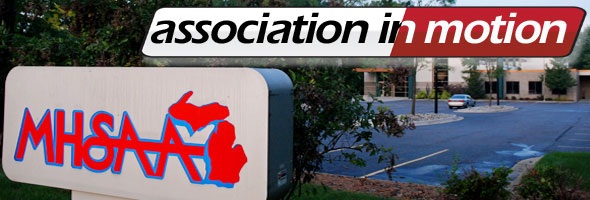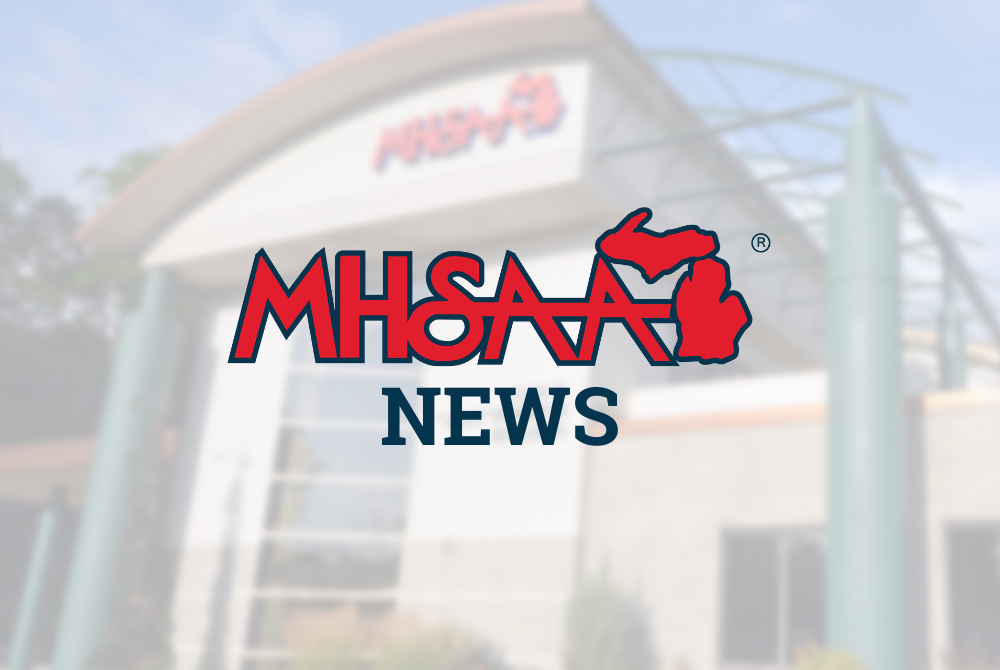
Vermontville Star Named to NFHS Hall
March 1, 2016
By Geoff Kimmerly
Second Half editor
Record-setting Vermontville High School baseball star Ken Beardslee, who continues to hold two national strikeout records more than 65 years after his final high school pitch, was one of 12 individuals named Tuesday to the National High School Sports Hall of Fame by the National Federation of State High School Associations (NFHS).
 Beardslee, who died in 2007, will be inducted as one of five athletes selected for the 34th Hall of Fame class at a ceremony during the NFHS summer meeting July 2 in Reno, Nev.; the rest of the class is made up of coaches, administrators and an official. He was nominated through the Michigan High School Athletic Association.
Beardslee, who died in 2007, will be inducted as one of five athletes selected for the 34th Hall of Fame class at a ceremony during the NFHS summer meeting July 2 in Reno, Nev.; the rest of the class is made up of coaches, administrators and an official. He was nominated through the Michigan High School Athletic Association.
Beardslee has been proclaimed as “prep baseball’s first ace” in the NFHS National High School Sports Record Book and was featured in the former print version of the book for his incredible feats from 1947-49. In his three years on the mound for Vermontville, Beardslee won 24 of his 25 starts (the team was 31-1 during that time). His 24 victories included eight no-hitters, with two perfect games, and seven one-hitters.
He set seven national records, and two still stand after 66 years: his per-game season strikeout mark of 19.0 and his per-game career strikeout mark of 18.1.
Beardslee will become the Hall of Fame’s eighth inductee from Michigan, joining Charles Forsythe, the first executive director of the Michigan High School Athletic Association (inducted 1983); River Rouge boys basketball coach Lofton Greene (1986), Warren Regina softball coach Diane Laffey (2000), Fennville basketball, football, track and baseball standout Richie Jordan (2001), Grosse Pointe Woods University Liggett boys and girls tennis coach Bob Wood (2005), Bloomfield Hills Cranbrook hockey standout Jim Johnson (2007) and Owosso football, basketball and baseball all-stater Brad Van Pelt (2011).
“It’s been said that records are made to be broken,” wrote MHSAA Executive Director John E. “Jack” Roberts in his letter supporting Beardslee’s nomination. “But the strikeout numbers Ken Beardslee recorded in the late 1940s have stood the test of time, just like some of the shutout and strikeout numbers 2009 Hall of Fame honoree David Clyde amassed some 20 years later. But Clyde never came close to Beardslee’s 19.0 Ks per game in a season or 18.1 per game for a career, and neither has anyone else.”
Beardslee is listed 10 times in the MHSAA record book. He shares the record for career no-hitters and is second with two career perfect games and a 0.32 career earned run average. In addition to his two national strikeout records still standing, he’s listed in the MHSAA records with games of 26, 25 (both extra innings) and 20 strikeouts (in seven innings) during the 1949 season. His 209 strikeouts that spring rank fourth for one season in MHSAA history, and his 452 over three seasons rank 12th on the career strikeouts list.
Beardslee was drafted by the New York Yankees immediately after graduating from high school and pitched in the minor leagues from 1949 to 1956, when an injury ended his playing career. Beardslee went on to scout for the Pittsburgh Pirates for 21 years, and he received a World Series ring after the team’s championship win in 1971. He also went on to write eight books including novels, poetry and an instructional on pitching.
He is survived by his wife Marilene, who is expected to attend the ceremony this summer to accept his honor.
The National High School Hall of Fame was started in 1982 by the NFHS. This year’s class increases the number of individuals in the Hall of Fame to 447.
The 12 individuals were chosen after a two-level selection process involving a screening committee composed of active high school state association administrators, coaches and officials, and a final selection committee composed of coaches, former athletes, state association officials, media representatives and educational leaders. Nominations were made through NFHS member associations. Also chosen for this class were athletes Steve Spurrier (Tennessee), Marlin Briscoe (Nebraska), Joni Huntley (Oregon) and Tom Southall (Colorado); coaches Chuck Kyle (Ohio), Peg Kopec (Illinois), Pete Boudreaux (Louisiana) and Jack Holloway (Delaware); administrators Tim Flannery (NFHS) and Ennis Proctor (Mississippi), and official Eugene “Lefty” Wright (Minnesota).
For more on this year’s Hall of Fame class, visit the NFHS Website. For more on Michigan’s past inductees, visit the MHSAA Website.

Council Discusses Transfer, 5th-Quarter Rules in Charting Future Work During Fall Meeting
By
Geoff Kimmerly
MHSAA.com senior editor
December 18, 2025
The Representative Council of the Michigan High School Athletic Association considered several reports concerning ongoing business relevant to its member schools, discussed topics surrounding the MHSAA’s transfer and 5th-quarter rules, and conducted its annual elections among other activities during its Fall Meeting on Dec. 5 in East Lansing.
Generally, the Council takes only a few actions during its Fall Meeting, with topics often introduced for additional consideration and action during its meetings in March and May. The Council took only one action at this meeting, to approve its annual audit, but discussed several topics that will be delved into further throughout the remainder of this school year.
A significant portion of Council discussion regarded the MHSAA transfer and 5th-quarter allowance rules. The transfer conversation focused primarily on students who play as part of non-MHSAA sports organizations during their first year or years of high school but wish to then play at a member high school. The Council also received an update on the Transfer Tracker tool under development that will provide schools greater guidance on eligibility determinations by monitoring when students change schools after ninth grade.
The 5th-quarter conversation considered how allowances made in recent years in basketball, football, soccer, lacrosse, baseball and field hockey have aligned with the intent of that allowance – to help schools save subvarsity teams from elimination because of low participation by allowing athletes to play on varsity and subvarsity teams simultaneously over a set number of periods each week.
The Council received updates on this fall’s inaugural MHSAA Field Hockey Tournament and also on the first boys volleyball season to be played during Spring 2026. MHSAA staff also informed the Council on a baseball rule proposal that would require a double first base, recent viewership of NFHS Network broadcasts, and MHSAA Sports Medicine Advisory Committee discussions especially concerning the statewide shortage of athletic trainers in schools. Additional updates were provided on MHSAA athletic director Update meeting and in-service programs and other administrative topics.
The Fall Meeting also saw elections of Council officers for the upcoming year. Brighton athletic director John Thompson was reelected president after completing the previous president’s term this summer and fall. Calumet teacher and past athletic director Sean Jacques was reelected as Council vice president after completing Thompson’s term, and Vic Michaels, director of physical education and athletics for the Archdiocese of Detroit, was reelected as secretary-treasurer.
Additionally, Wyoming Godfrey-Lee Schools superintendent Arnetta Thompson and Freeland Middle School principal Jennifer Thunberg were appointed for second two-year terms on the Council.
The Representative Council is the legislative body of the MHSAA. All but five members are elected by member schools. Four members are appointed by the Council to facilitate representation of females and minorities, and the 19th position is occupied by the Superintendent of Public Instruction or designee.
The MHSAA is a private, not-for-profit corporation of voluntary membership by more than 1,500 public and private senior high schools and junior high/middle schools which exists to develop common rules for athletic eligibility and competition. No government funds or tax dollars support the MHSAA, which was the first such association nationally to not accept membership dues or tournament entry fees from schools. Member schools which enforce these rules are permitted to participate in MHSAA tournaments, which attract more than 1.4 million spectators each year.

